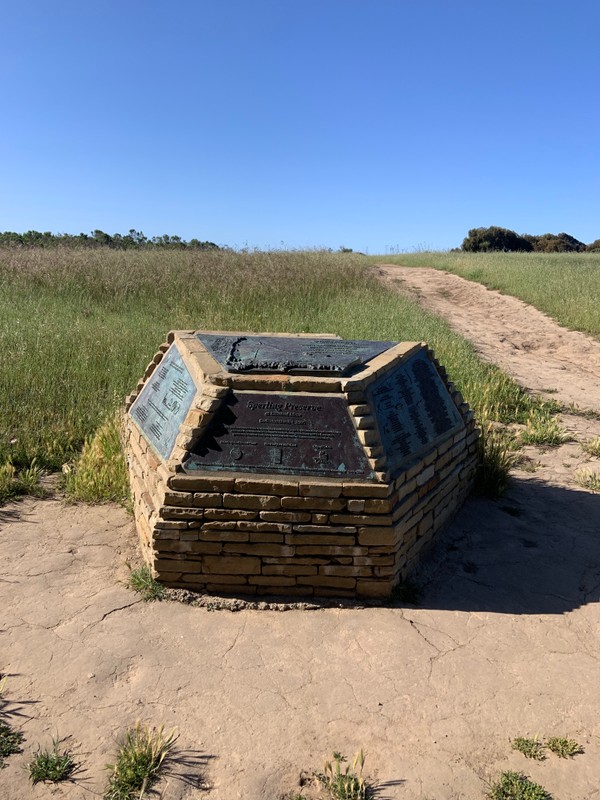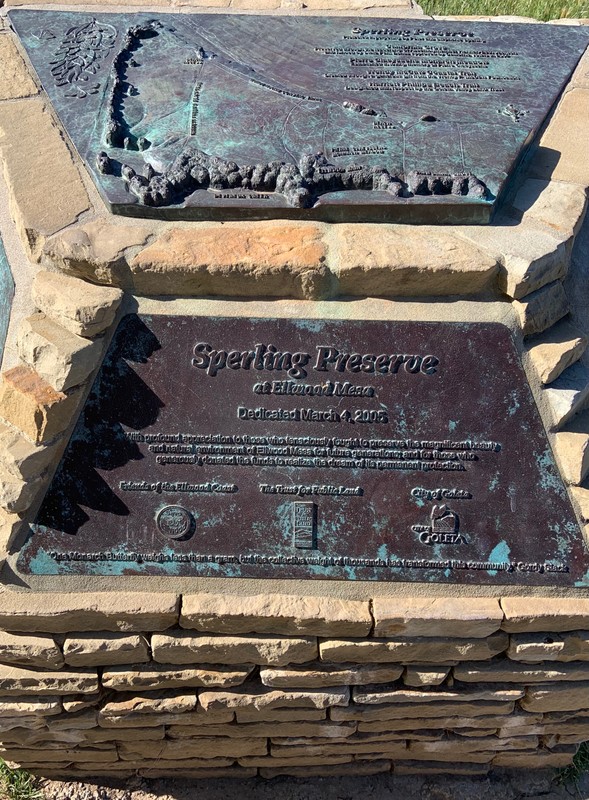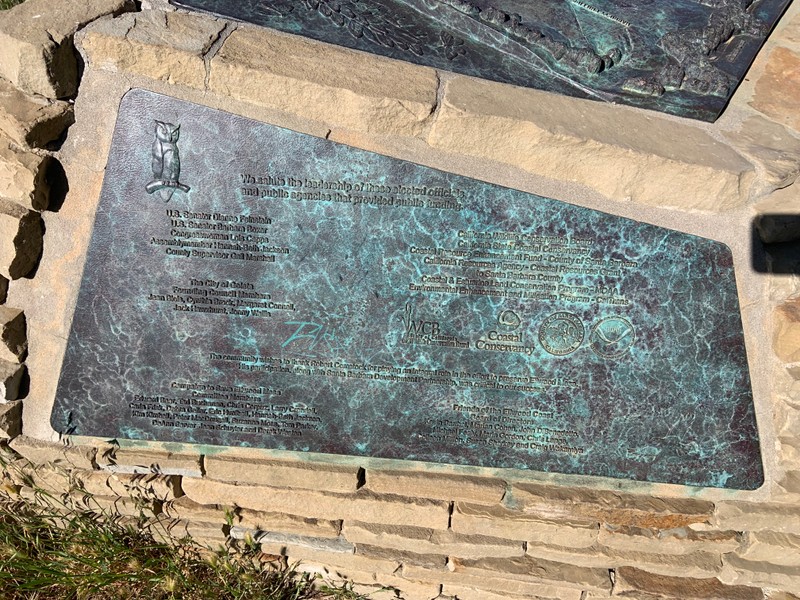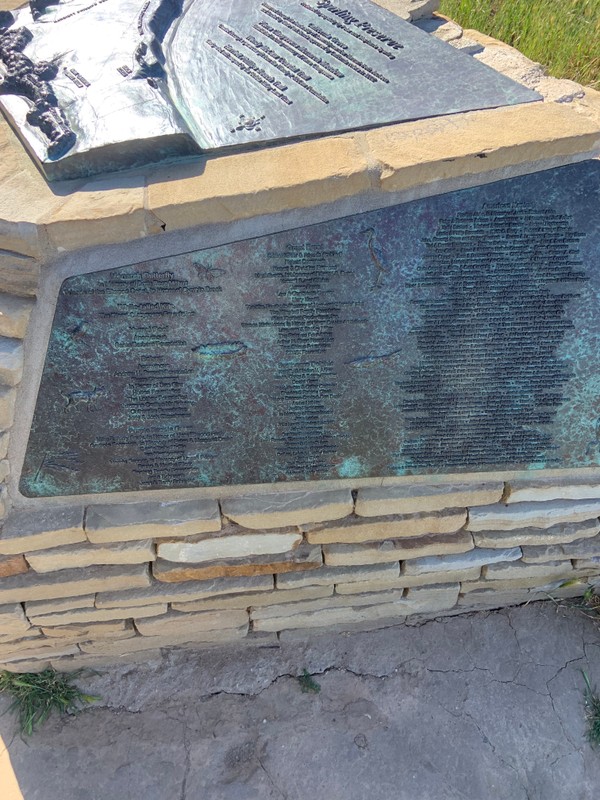Sperling Plaque
Introduction
Author-Uploaded Audio
Listen to a narration of this entry's description by Nicky Rehnberg.
Text-to-speech Audio
Recommended Time: 10 minutes
Continue walking back towards Isla Vista along the Eucalyptus and beside the Goleta neighborhood that runs right next to it.
While you walk, what do you notice? Are there any changes in the landscape that you see? What do the fences look like? Are they all the same or are they different? What do you think it would be like to live in the neighborhood so close to Ellwood Devereux – maybe you already do!
After a few minutes, you should bump into a big plaque made out of rough stones. Touch the stones. What do they feel like? If you have taken a geography class or really like rocks, what type of stone are they made of? What does the plaque note? What does it remember? Why do you think the plaque was placed here and why? Why have a plaque at all?
Let’s look closer at the plaque. On its top, there is a textured map of Ellwood Mesa. How accurate does it look? Why do you think it was included? After a few minutes of analyzing the top of the plaque, look at its sides. One of the sides list the legislators who made the work possible. Look at the names. Do any look familiar? What about their jobs – are you surprised by the kinds of politicians who did this work? Why or why not?
The other side of the plaque lists major donors, organized by different levels named after local fauna. The fight to protect Ellwood Mesa took decades, but most of the litigation and fundraising efforts occurred between 1993 and 2005. Read the next section to learn more about this process.
Images
Sperling Reserve Plaque

Sperling Reserve Plaque, Top

Sperling Reserve Plaque, Side

Sperling Reserve Plaque, Side

Backstory and Context
Author-Uploaded Audio
Listen to a narration of this entry's description by Nicky Rehnberg.
Text-to-speech Audio
At the last site, we talked a bit about the conservation and preservation of Ellwood Devereux since the 1980s. This plaque remembers the most recent efforts to do so.
While butterflies were definitely inspirational to the movement, there were other reasons why people wanted to get involved with “saving” this area. What do you think some of those reasons might be?
When faced with the stark reality that Ellwood Devereux could become high-income housing, environmental activists who had been, well, active since the 1969 oil spill tried to find ways to protect it. Some in Goleta who were involved with environmental planning and knew the area really well suggested that Santa Barbara County “swap” land that it already owned as another park, to preserve Ellwood Mesa. Housing would then be developed north of Devereux Creek and away from the ocean.
At the same time, UCSB was looking to develop on Ellwood Mesa, and also agreed to develop away from the coastal bluffs. This swap was only possible because there had been decades of research and development planning regarding the local open spaces of Ellwood Devereux. Especially following the Santa Barbara oil spill, many faculty who worked with the environment in any way had banded together and with students to research and catalogue the area. Some of this work led to our campus’ herbarium, or collection of plants and plant information in an archive.
This type of work also helped create General and Specific Plans of the area. This meant that those involved in the land swap knew exactly what was on Ellwood Devereux, so they knew what legal standing they would have and what features would make Ellwood Devereux a poor place to build housing (but a great place to have a public park)!
This was not unheard of, it had been done before, but it was still unusual.
In order to do this, the Environmental Defense Center (EDC) worked with the local environmental group, Save Ellwood Shores, to sue Santa Barbara County (Goleta was not yet incorporated, meaning that it was not yet a city) in order to protect Ellwood Mesa against development.
Things began to change in 2001, however, when the land was bought by a new developer who had done some similar community-minded work and was open to working with the public. It was incredibly important for all of the stakeholders to work together and trust one another.
There was a slight problem: Ellwood Mesa was assessed to be worth more than the county’s park. So environmentalists had to fundraise. It was an all-hands-on deck situation, with Friends of the Ellwood Coast selling cupcakes with butterflies on them, private donations (the larger ones are noted on the plaques), and even Seinfeld’s Julia Louis Dreyfus came out and shot a commercial to continue to raise money! The largest amount of money was donated by UCSB alumni Peter Sperling, who loved the coastal bluffs and enjoyed surfing near them while a student, whose name is on the preserve itself.
Exploration Questions
- Imagine you are in charge of making a plaque on the conservation, preservation, and restoration of Ellwood Devereux. What would it look like and what would you include on it? Do you think plaques are the best way to commemorate this work? Why or why not?
- What does it mean to “save” a place? Can places – or anything, really – be “saved”? What would that look like in practice and how would it be accomplished?
- Housing is obviously a really important aspect for any community. It has also been exceptionally hard to house all students because of limited options near campus. Put another way, some would argue that open spaces like Ellwood Devereux would better serve the community if it could open up housing opportunities, especially if it was able to provide increased low-income housing. What do you think of that argument? Are there other ways that Ellwood Devereux serves as a home even if students (for the most part) do not sleep there?
Sources
Author's interview with Wayne Ferren, Jr., Scott Cooper, Cris Sandoval, Dan Gira, Robert Silsbee, Duncan Mellichamp, Carla Frisk, Linda Krop, Debra Geiler, and Lisa Stratton, 2018-2021.
Picture by Nicky Rehnberg
Picture by Nicky Rehnberg
Picture by Nicky Rehnberg
Picture by Nicky Rehnberg
